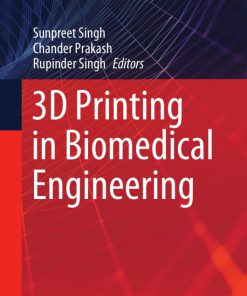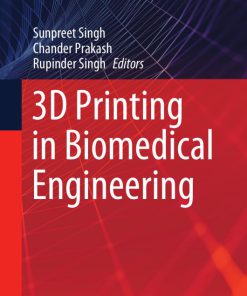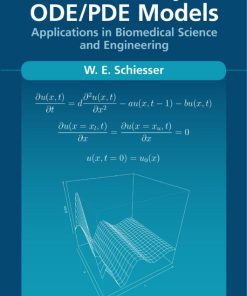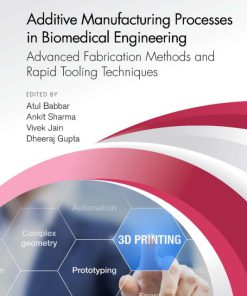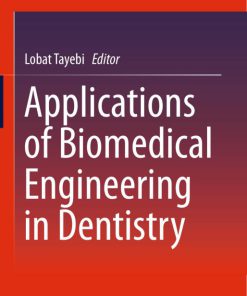(Ebook PDF) 3D and 4D Printing in Biomedical Applications Process Engineering and Additive Manufacturing 1st edition by Mohammed Maniruzzaman 9783527813698 full chapters
$50.00 Original price was: $50.00.$25.00Current price is: $25.00.
Authors:Mohammed Maniruzzaman , Series:Biomedical [109] , Author sort:Maniruzzaman, Mohammed , Languages:Languages:eng , Published:Published:Dec 2018 , Publisher:Wiley
3D and 4D Printing in Biomedical Applications: Process Engineering and Additive Manufacturing 1st edition by Mohammed Maniruzzaman – Ebook PDF Instant Download/DeliveryISBN: 9783527813698
Full download 3D and 4D Printing in Biomedical Applications: Process Engineering and Additive Manufacturing 1st edition after payment.
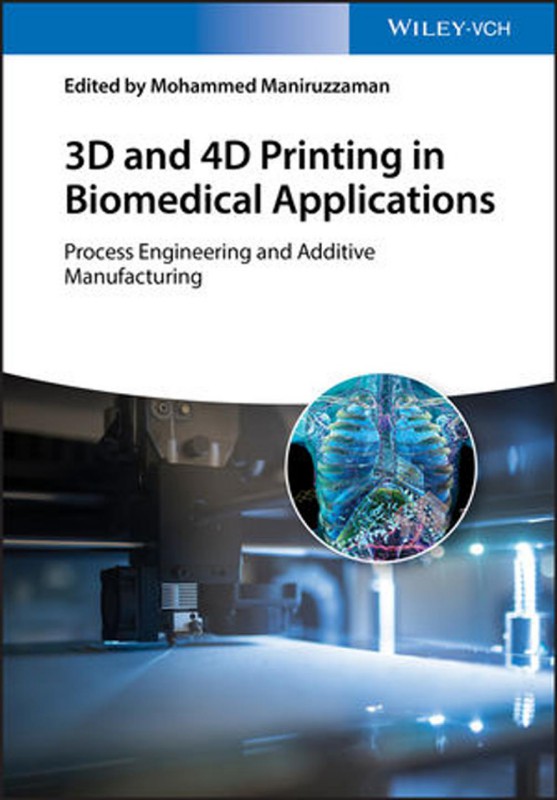
Product details:
ISBN-13 : 9783527813698
Author : Mohammed Maniruzzaman
3D and 4D Printing in Biomedical Applications offers an authoritative guide to 3D and 4D printing technology in the biomedical and pharmaceutical arenas. With contributions from an international panel of academic scholars and industry experts, this book contains an overview of the topic and the most current research and innovations in pharmaceutical and biomedical applications. This important volume explores the process optimization, innovation process, engineering, and platform technology behind printed medicine.
In addition, information on biomedical developments include topics such as on shape memory polymers, 4D bio-fabrications and bone printing.
3D and 4D Printing in Biomedical Applications: Process Engineering and Additive Manufacturing 1st Table of contents:
1 3D/4D Printing in Additive Manufacturing: Process Engineering and Novel Excipients 1
Christian Muehlenfeld and Simon A. Roberts
1.1 Introduction 1
1.2 The Process of 3D and 4D Printing Technology 1
1.3 3D/4D Printing for Biomedical Applications 2
1.4 Smart or Responsive Materials for 4D Biomedical Printing 3
1.5 Classification of 3D and 4D Printing Technologies 7
1.5.1 Fused Filament Fabrication (FFF) – Extrusion-Based Systems 7
1.5.2 Powder Bed Printing (PBP) – Droplet-Based Systems 10
1.5.3 Stereolithographic (SLA) Printing – Resin-Based Systems 12
1.5.4 Selective Laser Sintering (SLS) Printing – Laser-Based Systems 15
1.6 Conclusions and Perspectives 17
References 17
2 3D and 4D Printing Technologies: Innovative Process Engineering and Smart Additive Manufacturing 25
Deck Tan, Ali Nokhodchi, and MohammedManiruzzaman
2.1 Introduction 25
2.2 Types of 3D Printing Technologies 25
2.2.1 Stereolithographic 3D Printing (SLA) 25
2.2.2 Powder-Based 3D Printing 26
2.2.3 Selective Laser Sintering (SLS) 27
2.2.4 Fused Deposition Modeling (FDM) 28
2.2.5 Semisolid Extrusion (EXT) 3D Printing 29
2.2.6 Thermal Inkjet Printing 30
2.3 FDM 3D Printing Technology 31
2.3.1 FDM 3D Printing Applications in Unit Dose Fabrications and Medical Implants 33
2.4 Hot Melt Extrusion Technique to Produce 3D Printing Polymeric Filaments 34
2.5 Smart Medical Implants Integrated with Sensors 35
2.5.1 Examples of Medical Implants with Sensors 36
2.6 4D Printing and Future Perspectives 38
2.6.1 4D Printing and Its Transition in Material Fabrication 38
2.6.2 Shape Memory or Stimuli-Responsive Mechanism of 4D Printing 39
2.6.3 Factors Affecting 4D Printing 40
2.6.3.1 Humidity-Responsive Materials 40
2.6.3.2 Temperatures 41
2.6.3.3 Electronic and Magnetic Stimuli 43
2.6.3.4 Light 45
2.6.4 Future Perspectives of 4D Printing 45
2.7 Regulatory Aspects 46
2.8 Conclusions 48
References 48
3 3D Printing: A Case of ZipDose®Technology –World’s First 3D Printing Platform to Obtain FDA Approval for a Pharmaceutical Product 53
Thomas G.West and Thomas J. Bradbury
3.1 Introduction 53
3.2 Terminology 53
3.3 Historical Context forThis Form of 3D Printing 54
3.4 ZipDose®Technology 56
3.5 3D PrintingMachines and Pharmaceutical Process Design 60
3.5.1 Overview 60
3.5.2 Generalized Process in the Pharmaceutical Context 62
3.5.3 Exemplary 3DP Machine Designs 65
3.6 Development of SPRITAM® 70
3.6.1 Product Concept and Need 70
3.6.2 Regulatory Approach 71
3.6.3 Introduction of the Technology to FDA 72
3.6.4 Target Product Profile 72
3.6.5 Synopsis of Formulation and Clinical Development 73
3.7 Conclusion 76
Acknowledgments 77
References 77
4 Manufacturing of Biomaterials via a 3D Printing Platform 81
Patrick Thayer, Hector Martinez, and Erik Gatenholm
4.1 AdditiveManufacturing and Bioprinting 81
4.2 Bioinks 83
4.2.1 Printability Control – Bioink Composition and Environmental Factors 83
4.2.2 Mechanisms for Filament Formation and Stability 85
4.3 3D Bioprinting Systems 87
4.3.1 Multifaceted Systems 88
4.3.2 Major Components 88
4.3.3 Pneumatic Printhead 89
4.3.4 Mechanical Displacement Printhead 89
4.3.5 Inkjet Printhead 91
4.3.6 Heated and Cooled Printheads 91
4.3.7 High-Temperature Extruder 92
4.3.8 Multimaterial Printhead 92
4.3.9 Heated and Cooled Printbed 94
4.3.10 Clean Chamber Technology 94
4.3.11 Video-Capture Printhead and Sensors 94
4.3.12 Integrated Intelligence 95
4.4 Applications 95
4.4.1 Internal Architecture 96
4.4.2 Integrated Vascular Networks and Microstructure Patterning 98
4.4.3 PersonalizedMedicine 99
4.5 Steps Necessary for Broader Application 101
References 102
5 Bioscaffolding: A New Innovative Fabrication Process 113
Rania Abdelgaber, David Kilian, and Hendrik Fiehn
5.1 Introduction: From Bioscaffolding to Bioprinting 113
5.2 Scaffolding 115
5.2.1 Properties of Scaffolds 115
5.2.2 Bioprinters vs Common 3D Printers: Approaches for Extrusion of Polymers 116
5.2.3 Comparing Cell Seeding Techniques to 3D Bioprinting or Cell-Laden Hydrogels 117
5.2.3.1 From Printing to Bioprinting 117
5.2.3.2 Approaches of Stabilizing Printed Constructs 118
5.2.4 Examples/Applications of Cell-Seeded Scaffolds 119
5.2.5 Data Processing of 3D CAD Data for Bioscaffolds 119
5.3 Bioprinted Scaffolds 120
5.3.1 Bioinks 120
5.3.2 Tools for Multimaterial Printing 123
5.3.3 Multimaterial Scaffold 124
5.3.4 Core–Shell Scaffolds 126
5.3.5 Additional Technical Equipment 128
5.3.6 Piezoelectric Pipetting Technology 128
5.3.7 Usage of Piezoelectric Inkjet Technology with Bioscaffolds 130
5.4 Applications of Bioscaffolder and Bioprinting Systems 132
5.4.1 Individualized Implants and Tissue Constructs 132
5.4.2 Green Bioprinting 133
5.4.3 Challenges for Clinical Applications of Bioprinted Scaffolds in Tissue and Organ Engineering 134
5.4.4 4D Printing 135
5.5 Conclusion 137
References 137
6 Potential of 3D Printing in Pharmaceutical Drug Delivery and Manufacturing 145
Maren K. Preis
6.1 Introduction 145
6.2 Pharmaceutical Drug Delivery 145
6.3 Conventional Manufacturing vs 3D Printing 146
6.4 Advanced Applications for Improved Drug Delivery 148
6.5 Instrumentations 148
6.6 Location of 3D Printing Manufacturing 149
6.6.1 Pharmaceutical Industry 149
6.6.2 At the Point of Care 150
6.6.3 Print-at-Home 150
6.7 Regulatory Aspects 151
6.8 Summary 151
References 151
7 Emerging 3D Printing Technologies to Develop Novel Pharmaceutical Formulations 153
Christos I. Gioumouxouzis, Georgios K. Eleftheriadis, and Dimitrios G. Fatouros
7.1 Introduction 153
7.2 FDM 3D Printing 153
7.3 Pressure-Assisted Microsyringe 173
7.4 SLA 3D Printing 175
7.5 Powder Bed 3D Printing 175
7.6 SLS 3D Printing 178
7.7 3D Inkjet Printing 179
7.8 Conclusions 180
References 180
8 Modulating Drug Release from3D Printed Pharmaceutical Products 185
Julian Quodbach
8.1 Introduction 185
8.2 Pharmaceutically Used 3D Printing Processes and Techniques 186
8.2.1 Process Flow of 3D Printing Processes 186
8.2.2 Inkjet-Based Printing Technologies 187
8.2.3 Extrusion-Based Printing Techniques 187
8.2.4 Laser-Based Techniques 188
8.3 Modifying the Drug Release Profile from 3D Printed Dosage Forms 189
8.3.1 Approaches to Modify the Drug Release 189
8.3.2 Modifying the Drug Release by Formulation Variation 189
8.3.2.1 Fused Filament Fabrication 189
8.3.2.2 Other Printing Techniques 194
8.3.3 Manipulating the Dosage Form Geometry as a Means to Modify API Release 195
8.3.3.1 Fused Filament Fabrication 196
8.3.3.2 Drop-on-Drop Printing 197
8.3.4 Dissolution Control via Directed Diffusion and Compartmentalization 199
8.3.4.1 Drop-on-Powder Printing 199
8.3.4.2 Fused Filament Fabrication 202
8.3.4.3 Printing with Pressure-Assisted Microsyringes 205
8.4 Conclusion 206
References 207
9 Novel Excipients and Materials Used in FDM 3D Printing of Pharmaceutical Dosage Forms 211
Ming Lu
9.1 Introduction 211
9.2 Biodegradable Polyester 219
9.2.1 Polylactic Acid (PLA) 219
9.2.2 Poly(ε-caprolactone) (PCL) 220
9.3 Polyvinyl Polymer 221
9.3.1 Polyvinyl Alcohol (PVA) 221
9.3.2 Ethylene Vinyl Acetate (EVA) 223
9.3.3 Polyvinylpyrrolidone (PVP) 224
9.3.4 Soluplus 225
9.4 Cellulosic Polymers 225
9.4.1 Hydroxypropyl Cellulose (HPC) 226
9.4.2 Hydroxypropyl Methylcellulose (HPMC) 227
9.4.3 Hydroxypropyl Methylcellulose Acetate Succinate (HPMCAS) 228
9.5 Polymethacrylate-Based Polymers 229
9.5.1 Eudragit RL/RS 230
9.5.2 Eudragit L100-55 231
9.5.3 Eudragit E 100 232
9.6 Conclusion 233
References 234
10 Recent Advances of NovelMaterials for 3D/4D Printing in Biomedical Applications 239
Jasim Ahmed
10.1 Introduction 239
10.2 Materials for 3DP 240
10.3 Rheology 241
10.4 Ceramics for 3D Printing 241
10.5 Polymers and Biopolymers for 3D Printing 243
10.5.1 Polylactide (PLA) 245
10.5.2 Poly(ε-caprolactone) (PCL) 245
10.5.3 Hyaluronic Acid 245
10.6 4D Printing 246
10.6.1 Bioprinting 246
10.6.2 Smart or Intelligent Materials 249
10.6.2.1 Thermal Stimuli-Induced Transformation 249
10.6.2.2 Hydrogel 253
10.7 3D and 4D Printed Bone Scaffolds with Novel Materials 255
10.7.1 3DP/4DP for Drug Delivery and Bioprinting 259
10.7.2 Polyurethane-Based Scaffolds for Tissue Engineering 260
10.8 Future and Prospects 263
References 264
11 Personalized Polypills Produced by Fused Deposition Modeling 3D Printing 273
Sheng Qi, Jehad Nasereddin, and Fahad Alqahtani
11.1 Introduction 273
11.2 Polypharmacy and Polypills 275
11.2.1 Clinical Evidence and Current State of the Art 275
11.2.2 Future Personalization 276
11.3 FDM 3D Printing of Pharmaceutical Solid Dosage Forms 279
11.3.1 Basic Principle of FDM 3D Printing 279
11.3.2 Printing Parameter Control 281
11.3.3 Drug-Loading Methods 285
11.4 Key Challenges in the Development of FDM 3D Printed Personalized Polypills 287
11.4.1 Printable Pharmaceutical Materials 287
11.4.2 Printing Precision and Printer Redesign 288
11.4.3 Regulatory Barriers for Personalized Polypill Printing 290
11.5 Conclusions and Future Remarks 292
References 292
12 3D Printing of Metallic Cellular Scaffolds for Bone Implants 297
Xipeng Tan and Yu Jun Tan
12.1 Introduction 297
12.2 Metal 3D Printing Techniques for Bone Implants 299
12.2.1 Selective Laser Melting 301
12.2.2 Selective Electron Beam Melting 302
12.3 Biometals for Bone Implants 303
12.3.1 Nondegradable Biometals 304
12.3.2 Biodegradable Biometals 305
12.3.3 3D Printing of Biometals 306
12.3.3.1 Ti–6Al–4V ELI Alloy 306
12.3.3.2 CoCrMo Alloy 307
12.3.3.3 Stainless Steel 316L Alloy 307
12.3.3.4 NiTi Shape Memory Alloy 308
12.3.3.5 Tantalum 309
12.3.3.6 Mg and Its Alloy 309
12.4 Cellular Structure Design 310
12.4.1 Stochastic and Reticulated Cellular Design 311
12.4.2 Bend- and Stretch-Dominated Cellular Design 312
12.4.3 Scaffold Design Feasibility 312
12.5 Outlook 313
References 314
13 3D and 4D Scaffold-Free Bioprinting 317
Chin Siang Ong, Pooja Yesantharao, and Narutoshi Hibino
13.1 Introduction 317
13.2 3D Scaffold-Free Bioprinting 318
13.2.1 Principles 318
13.2.2 Spheroid Optimization 318
13.2.3 3D Bioprinting 322
13.2.4 Decannulation and Functional Assessment 325
13.3 4D Bioprinting 326
13.3.1 Properties of “Smart” Materials 328
13.3.2 General Approaches 328
13.3.2.1 “Smart” Scaffolds 328
13.3.2.2 In Vivo Bioprinting 331
13.3.2.3 Hybrid Techniques 332
13.3.3 4D Bioprinting Technologies 332
13.3.4 Applications 334
13.3.5 Limitations and Future Directions 336
13.4 4D Scaffold-Free Bioprinting 337
13.5 Conclusion 338
Acknowledgments 338
References 338
14 4D Printing and Its Biomedical Applications 343
Saeed Akbari, Yuan-Fang Zhang, DongWang, and Qi Ge
14.1 Introduction 343
14.2 3D Printing Technologies with Potential for 4D Printing 344
14.2.1 Fused Deposition Modeling (FDM) 344
14.2.2 Direct InkWriting (DIW) 345
14.2.3 Inkjet 347
14.2.4 Projection Stereolithography (pSLA) 348
14.3 Soft Active Materials for 4D Printing 349
14.3.1 Shape Memory Polymers 349
14.3.2 Hydrogels 354
14.3.3 Other SAMs 356
14.4 Biomedical Applications of 4D Printing 358
14.4.1 Temperature-Actuated 4D Printing 358
14.4.2 Humidity-Actuated 4D Printing 363
14.5 Conclusion and Outlook 365
References 366
15 Current Trends and Challenges in Biofabrication Using Biomaterials and Nanomaterials: Future Perspectives for 3D/4D Bioprinting 373
Luciano P. Silva
15.1 Introduction 373
15.2 Biofabrication as a Multidisciplinary to Interdisciplinary Research Field 375
15.3 Biofabrication as a Multifaceted Approach 377
15.4 Biofabrication Beyond Biomedical Pharmaceutical Applications 377
15.5 The Diversity of Techniques Used in Biofabrication 378
15.6 Natural Resources as Sources of Biomaterials Useful for Biofabrication 380
15.7 Nanomaterials as Much More Than Just New Building Blocks for Biofabrication 382
15.8 3D Bioprinting as the New Gold Standard for Biofabrication 383
15.9 When 3D Bioprinting Is Not Sufficient for Bioconstruction: 4D Bioprinting 385
15.10 An Overview about Current Bottlenecks in Biofabrication 385
15.10.1 Does 3D Model Matter in Biofabrication? 386
15.10.2 Does Size and Time Matter in Biofabrication? 386
15.10.3 Do Choice Materials and Cells Matters in Biofabrication? 387
15.10.4 Does Maturation of the Bioconstructs Matter in Biofabrication? 387
15.10.5 Do CharacterizationMethods Matters in Biofabrication? 388
15.10.6 Does Economic and Social Impact Matter Biofabrication? 388
15.10.7 Does Ethical and Legal Issues Matter in Biofabrication? 389
15.11 Conclusion 390
References 390
16 Orthopedic Implant Design and Analysis: Potential of 3D/4D Bioprinting 423
Chang JiangWang and Kevin B. Hazlehurst
16.1 Orthopedic Implant Design with 3D Printing 423
16.1.1 Bone Properties and Orthopedic Implants 423
16.1.2 3D Printing and Porous Implant Design 426
16.2 Analysis of 3D Printed Orthopedic Implants 428
16.2.1 Mechanical Properties of Porous Structures 429
16.2.2 Experimental Testing of 3D Printed Femoral Stems 433
16.2.3 Finite Element Analysis of Porous Stems with 3D Printing 435
16.3 3D Printed Orthopedic Implant Installation and Instrumentation 437
16.4 Orthopedic Implants Manufactured with 4D Printing 439
16.5 Summary 439
References 440
17 Recent Innovations in Additive Manufacturing across Industries: 3D Printed Products and FDA’s Perspectives 443
Brett Rust, Olga Tsaponina, andMohammedManiruzzaman
17.1 Introduction 443
17.2 CurrentWidely Used Processes across Industries 443
17.2.1 Fused Deposition Modeling (FDM) 443
17.2.2 Stereolithography (SLA) and Digital Light Processing (DLP) 444
17.2.3 Selective Laser Sintering (SLS) 445
17.3 Emerging 3D Printing Processes and Technologies 446
17.3.1 Continuous Liquid Interface Production (CLIP) 446
17.3.2 Multi Jet Fusion (MJF) 446
17.4 Industry Uses of AdditiveManufacturing Technologies 447
17.5 Material and Processes for Medical and Motorsport Sectors 449
17.6 Medical Industry Usage and Materials Development 452
17.7 3D Printing of Medical Devices: FDA’s Perspectives 455
17.7.1 FDA’s Role in 3D Printing of Materials 455
17.7.2 Classifications of Medical Devices from FDA’s Viewpoint 456
17.7.3 Medical Applications of 3D Printing and FDA’s Expectations 457
17.7.4 Person-Specific Devices 458
17.7.5 Process of 3D Printing of Various Medical Devices 458
17.7.6 Materials Used in 3D Printed Devices Overall 459
17.7.7 Materials Used in Specific Application (Printed Dental Devices) 460
17.8 Conclusions 461
People also search for 3D and 4D Printing in Biomedical Applications: Process Engineering and Additive Manufacturing 1st:
applications of 3d printing in healthcare
what is 3d and 4d printing
difference between 3d and 4d printing
what is 3d printing in medicine
applications of 3d printing in pharmaceuticals





